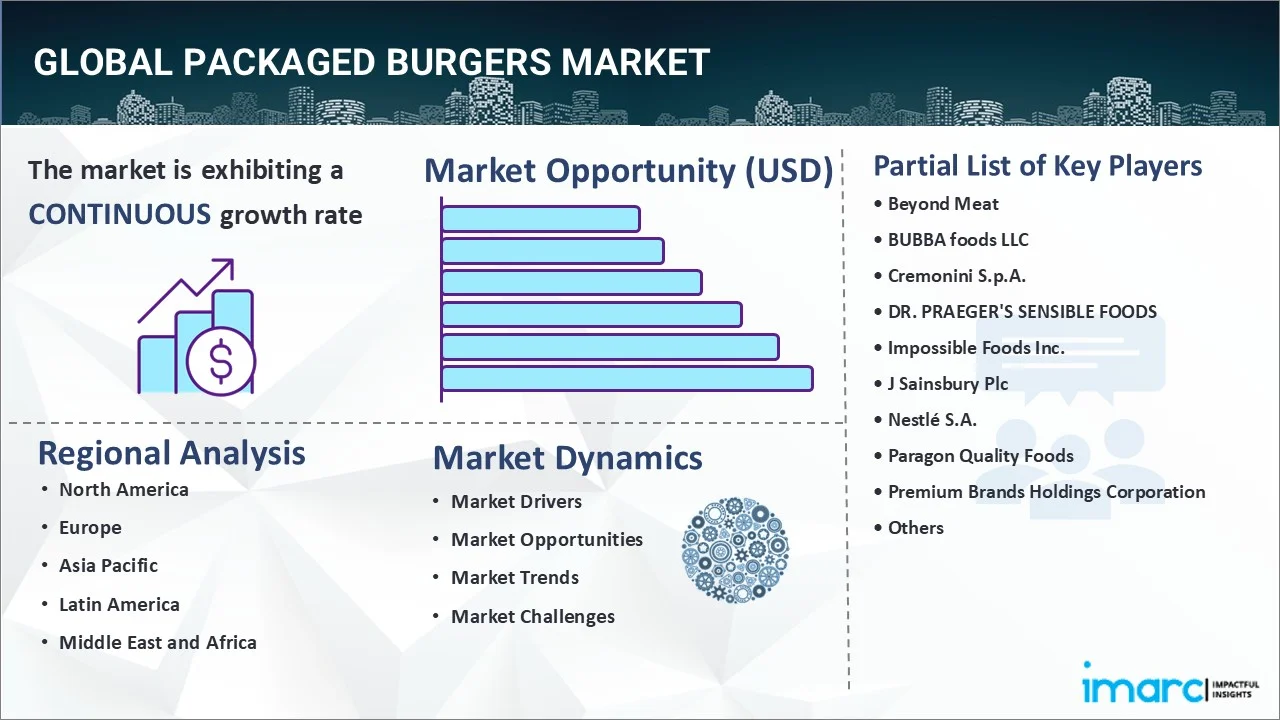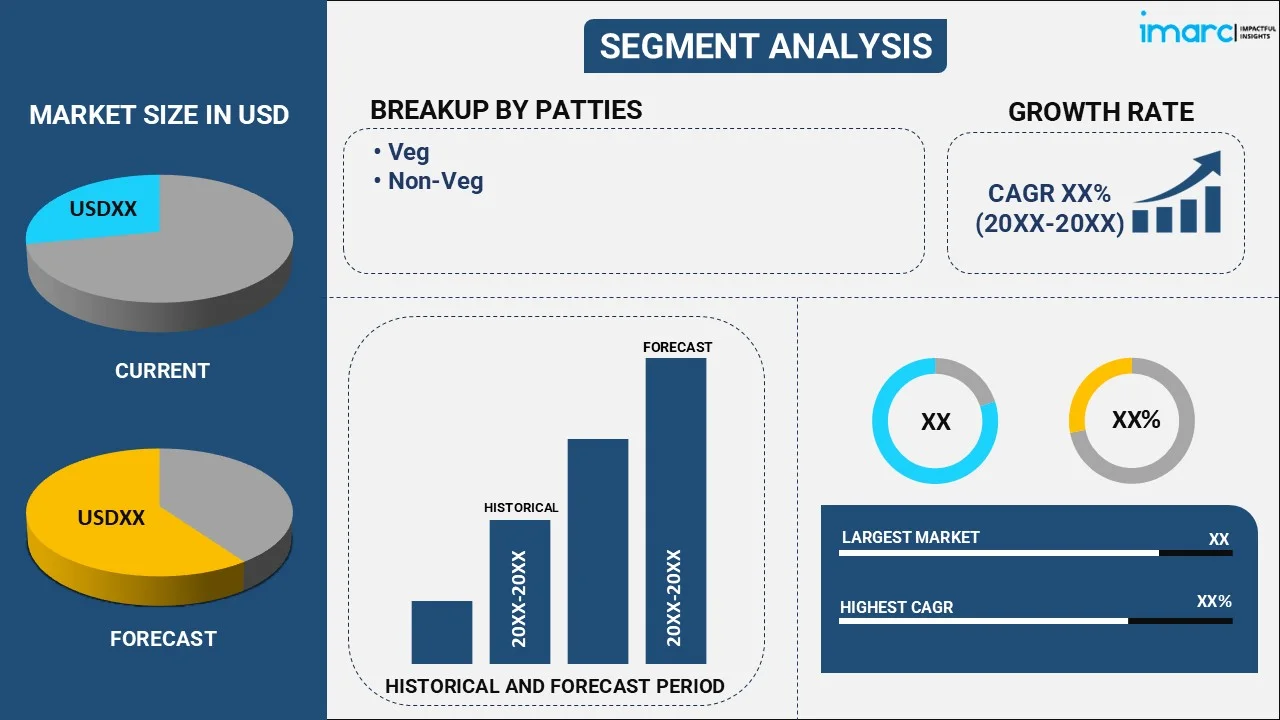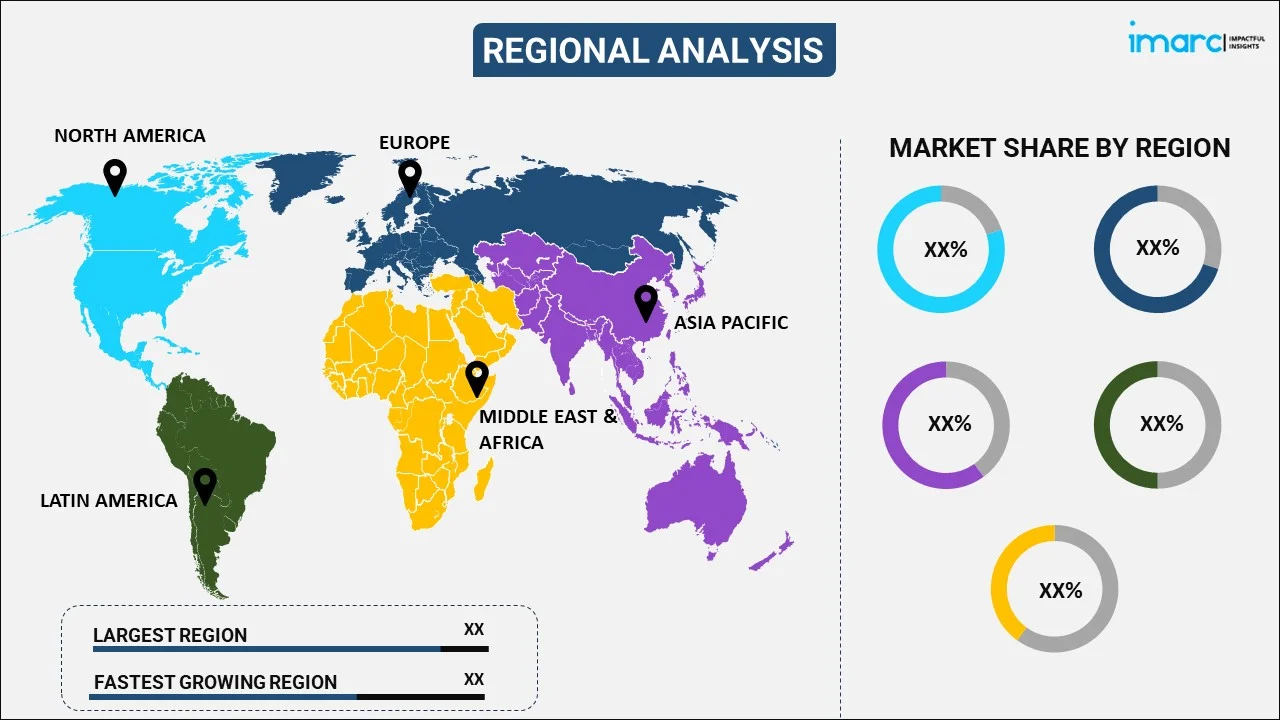
Packaged Burgers Market Report by Patty (Veg, Non-Veg), Product (Frozen, Fresh), Distribution Channel (Supermarkets and Hypermarkets, Convenience Stores, Online Stores, and Others), and Region 2025-2033
Global Packaged Burgers Market:
The global packaged burgers market size reached USD 3.8 Billion in 2024. Looking forward, IMARC Group expects the market to reach USD 7.8 Billion by 2033, exhibiting a growth rate (CAGR) of 7.4% during 2025-2033. The growing demand for convenient food options, emerging preferences for plant-based and vegetarian burger options, and the expansion on online sales and food delivery services are some of the key factors, catalyzing the packaged burger market growth.
|
Report Attribute
|
Key Statistics
|
|---|---|
|
Base Year
|
2024 |
|
Forecast Years
|
2025-2033
|
|
Historical Years
|
2019-2024
|
| Market Size in 2024 | USD 3.8 Billion |
| Market Forecast in 2033 | USD 7.8 Billion |
| Market Growth Rate (2025-2033) | 7.4% |
Packaged Burgers Market Analysis:
- Major Market Drivers: The increasing demand for convenience food products due to rapid urbanization, changing dietary patterns, and busy schedules represent one of the primary factors creating a positive outlook for the market. Moreover, several companies are offering packaged burgers in sustainable packaging and single-serve methods, which is also contributing to the market growth.
- Key Market Trends: The introduction of plant-based packaged burgers that contain extracts of carrot, beetroot, bell pepper, and protein-rich ingredients is one of the significant trends catalyzing the market growth. Additionally, the growing availability of packaged burgers across online retail channels is also bolstering the market growth.
- Competitive Landscape: Some of the leading companies operating in the global market include Beyond Meat, BUBBA foods LLC, Cremonini S.p.A., DR. PRAEGER'S SENSIBLE FOODS, Impossible Foods Inc., J Sainsbury Plc, Nestlé S.A., Paragon Quality Foods, Premium Brands Holdings Corporation, The Kellogg Company, and The Kraft Heinz Company, among many others.
- Geographical Trends: According to the report, Europe currently dominates the global market. The growth of the packaged burger market in the region can be attributed to the increasing number of working individuals, the rising immigrant population, and the inflating spending capacities of consumers. Furthermore, the presence of key market players in the region is positively impacting the packaged burger market price.
- Challenges and Opportunities: Challenges in the packaged burgers market include maintaining product freshness and quality standards during distribution. Opportunities lie in catering to the growing demand for convenient and ready-to-eat food options, leveraging innovation in flavors and packaging to appeal to diverse consumer preferences.

Global Packaged Burgers Market Trends:
Increasing Demand for Convenient Food Products
The rising preference for convenience food products is primarily driving the growth in the packaged burger market. Additionally, the rising working population across the globe, hectic work schedules, and inflating spending capacities of consumers are further catalyzing the packaged burger market demand. For instance, over 470 million people were estimated to be employed across India in 2021. Similarly, the civilian labor force in the U.S. amounted to around 167.12 million people in 2023, making it one of the largest in the world. Additionally, the expanding product offerings in the ready-to-eat and ready-to-cook food markets are also creating a positive outlook for the packaged burger market. For instance, according to IMARC, the global ready-to-eat (RTE) food market size reached US$ 181.5 Billion in 2023. Looking forward, IMARC Group expects the market to reach US$ 262.4 Billion by 2032, exhibiting a growth rate (CAGR) of 4.18% during 2024-2032. Rising preference for convenient food options is anticipated to propel the packaged burger market value over the forecasted period.
Rising Preferences for Plant-Based Burgers
Growing demand for plant-based burgers made from ingredients like soy, pea protein, and vegetables to cater to vegetarian and vegan consumers is offering lucrative growth opportunities to the overall market. Moreover, the escalating vegan population across the globe is contributing to the market growth. For instance, India is the leading nation by share of vegans. A total of 11% of the Indian population are vegans. Additionally, various key market players are increasingly investing in research and development activities to launch plant-based and healthier product variants, which is positively impacting the market outlook. For instance, in February 2024, Nestle India partnered with 'SOCIAL' and 'BOSS Burger' to launch plant-based delicacies. The lineup comprises alternatives for burger patties and mince, giving alternatives to traditional meat-based meals. In the same month, Smashburger, the better-burger fast-casual restaurant with around 235 corporate and franchise locations, partnered with Jack and Annie's to launch a new plant-based burger made from jackfruit in all locations across the U.S. Packaged burger market statistics suggest that such initiatives are anticipated to bolster the market growth in the coming years significantly.
Surge in Online Food Delivery
The surge in online food delivery services is driving growth in the packaged burger market by expanding access and convenience for consumers. Online platforms facilitate easy ordering of packaged burgers from a variety of brands, offering extensive menu options that cater to diverse tastes and dietary preferences. Various prominent burger-serving brands are integrating online delivery options to expand the consumer base and propel sales. For example, McDonald's future strategy is to build a strong digital platform to simplify access and provide customers with more purchasing options. Similarly, Chipotle's robust and customizable menu helps it to compete. Therefore, digital orders grew by 23% across the restaurant industry during 2019-2022. Similarly, in France, there were around 15 food delivery applications with more than 120,000 downloads, and these applications collectively had more than 10.3 million downloads in 2022. This trend is fueled by the convenience-seeking behavior of consumers who prefer ready-to-eat or easy-to-prepare meals delivered to their doorstep. The packaged burger market overview indicates that a surge in online food-delivering platforms is expected to catalyze market growth in the coming years.
Global Packaged Burgers Industry Segmentation:
IMARC Group provides an analysis of the key trends in each segment of the global packaged burgers market report, along with forecasts at the global, regional, and country levels from 2025-2033. Our report has categorized the market based on patty, product, and distribution channel.
Breakup by Patty:

- Veg
- Non-Veg
Veg holds the majority of the global market share
The report has provided a detailed breakup and analysis of the market based on the patty. This includes veg and non-veg. According to the report, veg holds the majority of the global market share.
The demand for veg burgers is increasing due to rising health consciousness, dietary preferences such as vegetarianism and veganism, and a growing interest in sustainable food choices among consumers worldwide. The escalating vegan population across the globe is contributing to the segment’s growth. For instance, India is the leading nation by share of vegans. A total of 11% of the Indian population are vegans. Additionally, according to IMARC, the global vegan food market size reached US$ 18.3 Billion in 2023. Looking forward, IMARC Group expects the market to reach US$ 39.8 Billion by 2032, exhibiting a growth rate (CAGR) of 9.03% during 2024-2032. The rising awareness and concerns about animal welfare, environmental sustainability, and health and wellness considerations are bolstering the packaged burgers market share.
Breakup by Product:
- Frozen
- Fresh
Frozen currently exhibits a clear dominance in the market
The report has provided a detailed breakup and analysis of the market based on the product. This includes frozen and fresh. According to the report, frozen currently exhibits a clear dominance in the market.
A frozen packaged burger is a convenient food product consisting of a pre-cooked or partially cooked patty typically made from beef, chicken, turkey, or plant-based ingredients. These burgers are individually wrapped and frozen to preserve freshness and extend shelf life. They offer consumers quick preparation options, often requiring simple heating in a microwave, oven, or on a grill. Frozen packaged burgers cater to busy lifestyles and provide consistent quality, making them popular in retail outlets and for home consumption. Varieties range from traditional meat-based options to vegetarian and vegan alternatives, reflecting diverse dietary preferences and convenience needs.
Breakup by Distribution Channel:
- Supermarkets and Hypermarkets
- Convenience Stores
- Online Stores
- Others
Supermarkets and hypermarkets account for the largest market share
The packaged burger market research report has provided a detailed breakup and analysis of the market based on the distribution channel. This includes supermarkets and hypermarkets, convenience stores, online stores, and others. According to the report, supermarkets and hypermarkets account for the largest market share.
Supermarkets and hypermarkets play crucial roles in the packaged burger market by offering extensive shelf space and diverse product selections to cater to varying consumer preferences. These retail channels provide convenient access to a wide range of frozen and refrigerated burgers, including traditional meat-based options and plant-based alternatives, meeting the demand for quick and easy meal solutions. Their strategic locations, coupled with promotional activities and competitive pricing, enhance product visibility and consumer awareness. Supermarkets and hypermarkets also leverage their robust logistics networks to ensure efficient distribution and consistent availability, making them pivotal in driving sales and market penetration for packaged burgers.
Breakup by Region:

- North America
- United States
- Canada
- Asia-Pacific
- China
- Japan
- India
- South Korea
- Australia
- Indonesia
- Others
- Europe
- Germany
- France
- United Kingdom
- Italy
- Spain
- Russia
- Others
- Latin America
- Brazil
- Mexico
- Others
- Middle East and Africa
Europe currently dominates the global market
The report has also provided a comprehensive analysis of all the major regional markets, which include North America (the United States and Canada); Europe (Germany, France, the United Kingdom, Italy, Spain, Russia, and others); Asia Pacific (China, Japan, India, South Korea, Australia, Indonesia, and others); Latin America (Brazil, Mexico, and others); and the Middle East and Africa. According to the report, Europe currently dominates the global market.
The growth of the packaged burger market in Europe can be attributed to the increasing number of working individuals, the rising immigrant population, and the inflating spending capacities of consumers. Furthermore, the presence of key market players in the region is also creating a positive outlook for the overall market. For instance, as of 2022, there were around 1,432 outlets of McDonald's and 750 Burger King outlets in Germany. The presence of major fast-food chains across the country is further propelling the market. Additionally, the growth of the online food delivery market in the region is also catalyzing the consumption of packaged burgers. For example, in France, there were 15 food delivery applications with more than 120,000 downloads, and these applications collectively had more than 10.3 million downloads in 2022. Such a surge in online food delivery and takeaways is anticipated to propel the packaged burger market revenue in the region over the forecasted period.
Competitive Landscape:
The competitive landscape of the industry has also been examined along with the profiles of the following key players:
- Beyond Meat
- BUBBA foods LLC
- Cremonini S.p.A.
- DR. PRAEGER'S SENSIBLE FOODS
- Impossible Foods Inc.
- J Sainsbury Plc
- Nestlé S.A.
- Paragon Quality Foods
- Premium Brands Holdings Corporation
- The Kellogg Company
- The Kraft Heinz Company
(Please note that this is only a partial list of the key players, and the complete list is provided in the report.)
Global Packaged Burgers Market News:
- May 2024: Verde Farms, the pioneer and leading brand of organic, 100% grass-fed, 100% pasture-raised beef, announced the launch of their newest offering, burger patties. The 80/20 organic and 100% grass-fed burger patties are accessible nationwide through Amazon Fresh and Verde's leading retail partners.
- May 2024: McDonald's announced plans to introduce bigger burgers to its menu in several markets across the world, including the United States.
- April 2024: Beyond Meat, Inc., a leader in plant-based meat, announced the launch of the fourth generation Beyond Burger and Beyond Beef at grocery stores nationwide.
Global Packaged Burgers Market Report Scope:
| Report Features | Details |
|---|---|
| Base Year of the Analysis | 2024 |
| Historical Period | 2019-2024 |
| Forecast Period | 2025-2033 |
| Units | Billion USD |
| Segment Coverage | Exploration of Historical Trends and Market Outlook, Industry Catalysts and Challenges, Segment-Wise Historical and Predictive Market Assessment:
|
| Patties Covered | Veg, Non-Veg |
| Products Covered | Frozen, Fresh |
| Distribution Channels Covered | Supermarkets and Hypermarkets, Convenience Stores, Online Stores, Others |
| Regions Covered | Asia Pacific, Europe, North America, Latin America, Middle East and Africa |
| Countries Covered | United States, Canada, Germany, France, United Kingdom, Italy, Spain, Russia, China, Japan, India, South Korea, Australia, Indonesia, Brazil, Mexico |
| Companies Covered | Beyond Meat, BUBBA foods LLC, Cremonini S.p.A., DR. PRAEGER'S SENSIBLE FOODS, Impossible Foods Inc., J Sainsbury Plc, Nestlé S.A., Paragon Quality Foods, Premium Brands Holdings Corporation, The Kellogg Company, The Kraft Heinz Company, etc. |
| Customization Scope | 10% Free Customization |
| Post-Sale Analyst Support | 10-12 Weeks |
| Delivery Format | PDF and Excel through Email (We can also provide the editable version of the report in PPT/Word format on special request) |
Key Benefits for Stakeholders:
- IMARC’s industry report offers a comprehensive quantitative analysis of various market segments, historical and current market trends, market forecasts, and dynamics of the packaged burgers market from 2019-2033.
- The research report provides the latest information on the market drivers, challenges, and opportunities in the global packaged burgers market.
- The study maps the leading, as well as the fastest-growing, regional markets. It further enables stakeholders to identify the key country-level markets within each region.
- Porter's five forces analysis assists stakeholders in assessing the impact of new entrants, competitive rivalry, supplier power, buyer power, and the threat of substitution. It helps stakeholders to analyze the level of competition within the packaged burgers industry and its attractiveness.
- The competitive landscape allows stakeholders to understand their competitive environment and provides insight into the current positions of key players in the market.
Key Questions Answered in This Report
We expect the global packaged burgers to exhibit a CAGR of 7.4% during 2025-2033.
The rising demand for processed and Ready-To-Eat (RTE) consumer goods and the introduction of gluten-free and high-protein packaged burgers with enhanced flavor in sustainable packaging are some of the key factors positively impacting the packaged burger market outlook.
The sudden outbreak of the COVID-19 pandemic has led to the changing consumer inclination from conventional brick-and-mortar distribution channels towards online retail platforms for the purchase of packaged burgers.
Based on the patty, the global packaged burgers market can be segmented into veg and non-veg. Currently, veg holds the majority of the global market share.
Based on the product, the global packaged burgers market has been divided into frozen and fresh, where frozen currently exhibits a clear dominance in the market.
Based on the distribution channel, the global packaged burgers market can be bifurcated into supermarkets and hypermarkets, convenience stores, online stores, and others. Among these, supermarkets and hypermarkets account for the largest market share.
On a regional level, the market has been classified into North America, Asia-Pacific, Europe, Latin America, and Middle East and Africa. According to the packaged burger market forecast by IMARC, Europe currently dominates the global market.
Some of the major players in the global packaged burgers market include Beyond Meat, BUBBA foods LLC, Cremonini S.p.A., DR. PRAEGER'S SENSIBLE FOODS, Impossible Foods Inc., J Sainsbury Plc, Nestlé S.A., Paragon Quality Foods, Premium Brands Holdings Corporation, The Kellogg Company, and The Kraft Heinz Company.
Need more help?
- Speak to our experienced analysts for insights on the current market scenarios.
- Include additional segments and countries to customize the report as per your requirement.
- Gain an unparalleled competitive advantage in your domain by understanding how to utilize the report and positively impacting your operations and revenue.
- For further assistance, please connect with our analysts.
 Request Customization
Request Customization
 Speak to an Analyst
Speak to an Analyst
 Request Brochure
Request Brochure
 Inquire Before Buying
Inquire Before Buying




.webp)




.webp)












